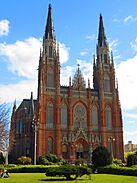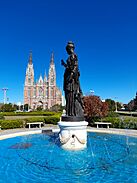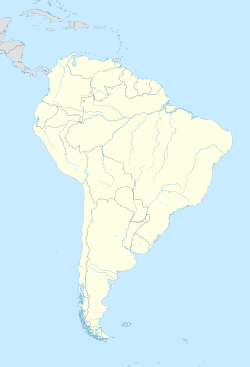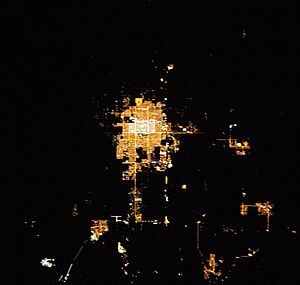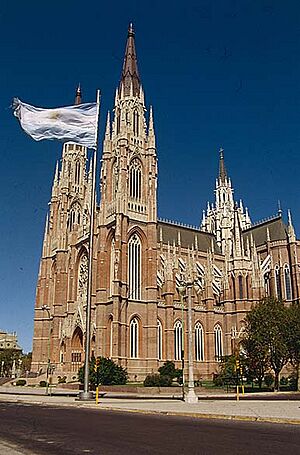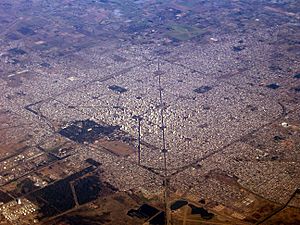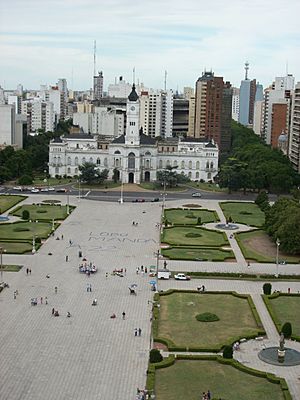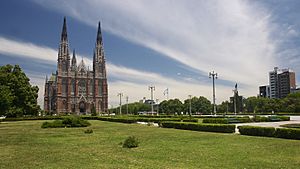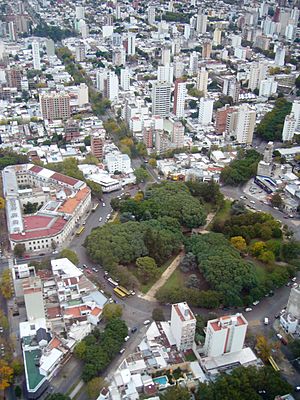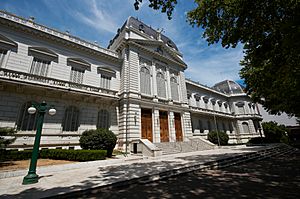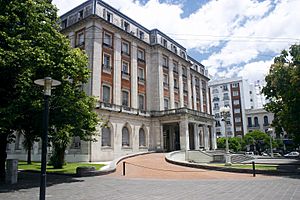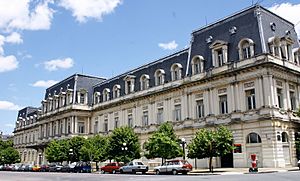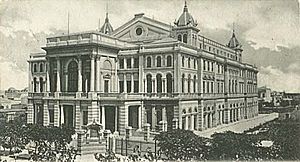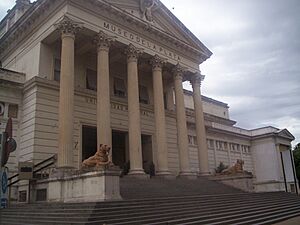La Plata facts for kids
Quick facts for kids
La Plata
|
||
|---|---|---|
|
City
|
||
| Ciudad de La Plata | ||
|
La Plata City Hall
Buenos Aires Government House
Cathedral of La Plata
Sculptures in the Plaza Moreno
La Plata Museum
La Plata railway station
Estadio Único Diego Armando Maradona
The Children's Republic
|
||
|
||
| Country | ||
| Province | ||
| Partido | La Plata | |
| Founded | 19 November 1882 | |
| Founded by | Dardo Rocha | |
| Area | ||
| • City | 27 km2 (10 sq mi) | |
| Elevation | 26 m (85 ft) | |
| Population
(2010 census)
|
||
| • City | 193,144 | |
| • Rank | 5th in Argentina | |
| • Density | 7,150/km2 (18,500/sq mi) | |
| • Urban | 904,789 | |
| • Metro | 924,000 | |
| Demonym(s) | platense | |
| Metropolitan GDP (PPP, constant 2015 values) | ||
| • Year | 2023 | |
| • Total | $19.6 billion | |
| • Per capita | $21,400 | |
| Time zone | UTC−3 (ART) | |
| CPA Base |
1900
|
|
| Area code(s) | +54 221 | |
La Plata is the capital city of Buenos Aires Province in Argentina. It's a big city with over 770,000 people living in the wider area. You can find it about 9 kilometers (6 miles) from the southern shore of the Río de la Plata estuary.
La Plata was specially designed to be the capital of the province. This happened after the city of Buenos Aires became the country's capital in 1880. Governor Dardo Rocha officially founded La Plata on November 19, 1882. For a short time, between 1952 and 1955, it was called Ciudad Eva Perón, named after Eva Perón.
Contents
- History of La Plata: A Planned City
- Important Places to See in La Plata
- La Plata in the 20th Century
- Sports and Stadiums
- City Layout and Architecture
- Awards and Recognition
- La Plata Cemetery
- Sports in La Plata
- Culture in La Plata
- Tourism in La Plata
- Notable People from La Plata
- Sister Cities
- Images for kids
- See also
History of La Plata: A Planned City

After La Plata was chosen as the provincial capital, Governor Rocha was in charge of building it. He hired Pedro Benoit, an urban planner, to design the city. Benoit created a unique layout that looks like a square. It has a main park in the center and two big diagonal avenues. These avenues run from north to south and east to west.
The city also has many other shorter diagonal streets. This design repeats itself in smaller sections of six by six blocks. Every six blocks, you'll find a small park or square. All other streets are in a rectangular grid and are numbered. Because of its many diagonal streets, La Plata is often called "the city of diagonals." It's also known as "the city of linden trees" because so many linden trees line its streets and squares.
The city's design and its buildings are said to have special symbols. This is because both Rocha and Benoit were part of a group called Freemasons.
The designs for the government buildings were chosen through a worldwide competition. For example, Italian architects designed the Governor Palace, and German architects designed the City Hall. In 1884, La Plata was the first city in Latin America to have electric street lighting.
Important Places to See in La Plata
The Cathedral of La Plata is a huge church built in a neo-Gothic style. It is the largest church in Argentina. You can find it on the central park, Plaza Moreno. It's also one of the tallest churches in the world.
The Teatro Argentino de La Plata is a very important opera house in Argentina. It's second only to the Teatro Colón in Buenos Aires. The first people living in La Plata helped pay for its construction. However, it was very expensive to keep up, so it was given to the Province of Buenos Aires. Sadly, a fire almost completely destroyed the building on October 18, 1977. This was a big loss for La Plata's history. A new building was later built. It now has several halls and is home to the theater's orchestra, choir, and ballet.
The Curutchet House is a special building. It's one of only two buildings in the Americas designed by the famous architect Le Corbusier.
The University of La Plata was started in 1897 and became a national university in 1905. It is famous for its observatory and natural history museum. Many famous people studied here, like Ernesto Sabato, a well-known novelist, and Doctor René Favaloro, who created a special heart surgery.
The San Ponciano church is located at the corner of 48th and 5th Streets. It was the first chapel in La Plata. Pedro Benoit himself drew the plans for this church. It opened on November 19, 1883, exactly one year after the city was founded. Its neo-Gothic style has been well preserved. The inner paintings are currently being restored. Governor Rocha named it "San Ponciano" to honor his son Ponciano and Pope Pontian.
La Plata in the 20th Century
In the 1920s, a large oil distillery was built in La Plata. At that time, it was the tenth largest in the world.
On December 10, 1945, Juan Domingo Perón and Eva Duarte were married in a church in La Plata.
In 1952, the city's name was changed to Ciudad Eva Perón. However, its original name, La Plata, was given back in 1955.
In March 1976, the Argentine military took control of the country. During this time, many students from La Plata faced difficulties. Some young, politically active students from a group called the Unión de Estudiantes Secundarios (Union of High School Students) were affected. This group worked for school and political changes. Many of these students disappeared or were harmed during a difficult period in Argentina's history.
In 1998, UNESCO considered making La Plata a World Heritage site. This recognition is still being reviewed. Some people believe that recent changes to the city's buildings and landscape have damaged its original design.
Sports and Stadiums
La Plata is home to two important football (soccer) teams. They are Estudiantes de La Plata and Gimnasia y Esgrima de La Plata. Both play in Argentina's top league.
Estudiantes de La Plata is the most successful club in the city. They have won seven national tournaments and four Copa Libertadores, which is a big South American competition. They also won the Intercontinental Cup against Manchester United in 1968. Many famous Argentine football figures, like Carlos Bilardo, came from Estudiantes.
Gimnasia de La Plata was founded in 1887. While they haven't won major titles in the professional era, they are a well-known team in the First Division.
The Estadio Ciudad de La Plata, also called "Estadio Único," opened in 2003. It is one of the most modern football stadiums in Latin America. It has been used for big games, including the 2011 Copa America and matches for the Pumas. It also hosts concerts.
Jorge Luis Hirschi Stadium is the home ground for Estudiantes. It is located on 1st Avenue in La Plata. Estadio Juan Carmelo Zerillo is the home ground for Gimnasia La Plata. You can find it in a park called El Bosque.
City Layout and Architecture
La Plata is a planned city with a very organized layout. It has a grid of square blocks with diagonal avenues crossing through. The two main diagonals, 73 and 74, meet at the city's center, Plaza Moreno. This square is very important. It holds the "foundation stone" and is the main square of the city. The City Hall and the cathedral of La Plata are located on its sides.
Other important buildings include the Museum of Natural Sciences, the Provincial Legislature, and the new theater. Many of these buildings were built when the city was founded. Their designs were chosen through international competitions.
The main building of the Banco de la Provincia de Buenos Aires is another notable structure. It was designed by architects Juan A. Buschiazzo and Luis Viglione and opened in 1886.
La Plata is a very green city. Its largest park is the "Paseo del Bosque" (or 'the forest'). There are also 22 other parks and squares with many trees. Other attractions include a lake, the Martin Fierro amphitheater, and the Zoo and Botanical Garden. The Victorian astronomical observatory and the Natural History Museum are also popular. A special place is the Children's Republic. It is said to have inspired Walt Disney to build Disneyland after he visited it.
In 1977, the city lost the Teatro Argentino de La Plata to a fire. A new theater was built in its place. The Estadio Ciudad de La Plata is a modern stadium in the city. It was designed in the 1970s. The stadium has been updated and now has a special roof made of Kevlar and plastic.
Awards and Recognition
La Plata received awards at the Exposition Universelle in Paris in 1889. The city won two gold medals for being the "City of the Future" and for "Better performance built." At this event, Jules Verne presented the award to Dardo Rocha.
La Plata Cemetery
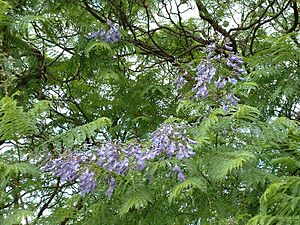
The municipal cemetery of La Plata was created in 1886 for the new capital. It was designed by Pedro Benoit. It has amazing architecture, both at its entrance and in many family tombs. You can see styles like neoclassical, Neo-Gothic, Art Nouveau, Art Deco, and Egyptian revival. The main entrance is a grand neo-classical archway with Doric columns.
Some people believe that the city's layout, with Diagonal 74 starting at the river and ending at the cemetery, was a symbol. It might represent the cycle of life and death, designed by Benoit.
Sports in La Plata
The main football (soccer) teams are Estudiantes de La Plata and Gimnasia y Esgrima La Plata. Estudiantes is the only team in the city to win national or international titles, including the Intercontinental Cup in 1968.
Basketball is also popular. The Gimnasia y Esgrima La Plata team plays in the Torneo Nacional de Ascenso (National Ascent Tournament). There are also local leagues and tournaments for all ages and skill levels.
Auto racing is important in La Plata. The city has a race track called Autódromo Roberto José Mouras. It is named after a famous driver. Gastón Mazzacane, a former Formula 1 driver, is also from La Plata.
Culture in La Plata
Culture is a big part of La Plata. The city has many cultural centers, theaters, museums, cinemas, and libraries. The Universidad Nacional de La Plata and the observatory also contribute to its rich cultural life.
- Cultural Centers: You can visit places like Centro Cultural Pasaje Dardo Rocha and Centro Cultural Islas Malvinas.
- Theaters: Enjoy a show at the Teatro Argentino de La Plata or Teatro Municipal Coliseo Podestá.
- Museums: Explore the Museo de Ciencias Naturales or the Museo de Arte Contemporáneo Latinoamericano.
- Libraries: The Biblioteca Central General José de San Martín is a great place to read.
- Cinemas: Catch a movie at Cinema City or Cinema Paradiso.
Many famous people in arts and culture are from La Plata. These include opera singer Paula Almerares, sculptor José Walter Gavito, and actor Benjamín Rojas. The city has also influenced musicians like Carlos "Indio" Solari.
Festivals and Events
La Plata has a special tradition called Quema de muñecos (Burning of Dolls). Every New Year's Eve, people build giant figures, often famous characters, out of wood and paper. They fill them with fireworks. After midnight, these figures are burned in a fiery show. People vote for the best doll, and the winner gets a prize.
On April 18, which is International Day For Monuments and Sites, you can take free bus tours. These tours visit historical places in La Plata and nearby cities.
Every year on November 19, the city celebrates its anniversary. There are concerts and fireworks at Plaza Moreno.
On September 21, La Plata celebrates the first day of spring and National Student's Day. The city organizes concerts in the Paseo del Bosque and Plaza Moreno.
Patron Saint
The patron saint of La Plata is Saint Ponciano. He was the 18th pope of the Catholic Church. His feast day is on November 19, which is also the city's founding day.
Tourism in La Plata
The most important tourist spots are in the heart of the city. This area is around Plaza Moreno, between Streets 51 and 53. The square separates two major landmarks: the Metropolitan Cathedral and the Palacio Municipal.

La Plata has many historical sites and monuments. Some of these include:
- The Banco Provincia de Buenos Aires headquarters.
- The Curutchet House.
- The Casa de Gobierno Provincial.
- The Centro Cultural Pasaje Dardo Rocha.
- The Museum of Natural Sciences.
- The Estadio Ciudad de La Plata.
- The Children's Republic.
You can also visit nearby cities like Berisso and Ensenada. They have interesting places like New York Street and the Fort Barragán Historical Museum.
Notable People from La Plata
- Julio Velasco (volleyball coach)
- Mauro Colagreco (chef)
- René Favaloro (heart surgeon)
- Cristina Fernández de Kirchner (former President of Argentina)
- Mercedes Lambre (actress)
- Martín Palermo (footballer)
- Emilio Pettoruti (painter)
- Benjamín Rojas (actor and musician)
- Marcos Rojo (footballer)
- Juan Sebastián Verón (footballer)
- Sergio Parisse (rugby player)
Sister Cities
La Plata has sister city relationships with many cities around the world. This means they share cultural and economic ties.
 Brazil, Porto Alegre, 1982
Brazil, Porto Alegre, 1982 Italy, Bologna, 1988
Italy, Bologna, 1988 Israel, Beersheba, 1989
Israel, Beersheba, 1989 Spain, Zaragoza, 1990
Spain, Zaragoza, 1990 Paraguay, Asunción, 1993
Paraguay, Asunción, 1993 Chile, Concepción, 1993
Chile, Concepción, 1993 United States, Louisville, 1994
United States, Louisville, 1994 Uruguay, Maldonado, 1994
Uruguay, Maldonado, 1994 Uruguay, Montevideo, 1994
Uruguay, Montevideo, 1994 Bolivia, Santa Cruz de la Sierra, 1994
Bolivia, Santa Cruz de la Sierra, 1994 Bolivia, Sucre, 1994
Bolivia, Sucre, 1994 France, Boulogne-sur-Mer, 2000
France, Boulogne-sur-Mer, 2000 United Kingdom, Liverpool, 2005
United Kingdom, Liverpool, 2005 China, Jiujiang, 2008
China, Jiujiang, 2008 Mexico Toluca, 2010
Mexico Toluca, 2010 Argentina, Mar del Plata, 2012
Argentina, Mar del Plata, 2012 Australia, Baw Baw
Australia, Baw Baw
Images for kids
-
The Presidency building of the UNLP.
See also
 In Spanish: La Plata para niños
In Spanish: La Plata para niños




